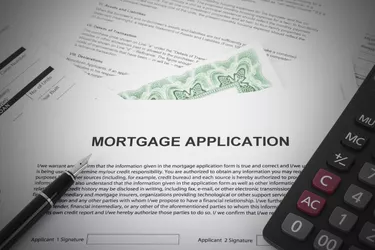
Candidates for conventional, uninsured loans are considered prime borrowers. They have at least a 20 percent down payment, good credit and enough income to make mortgage lenders feel safe. Lenders require insurance on loans when borrowers lack sufficient money or credit to offset the risk of financing a home. Standards for conventional, uninsured loans are stringent, but the loans are less expensive for borrowers.
Conventional Loan Definition and Limits
Video of the Day
Conventional lenders, including banks, credit unions and mortgage companies, often sell their loans to government-sponsored enterprises Fannie Mae and Freddie Mac. Not all mortgage lenders sell their loans; however, most do so to free up money for new loans. "Conventional" refers to the underwriting standards such loans must meet. Fannie's and Freddie's guidelines are usually similar, including their caps on loan amounts. As of August 2014, the conventional loan limit for a one-unit home in the continental U.S. was $417,000. This means that the GSEs buy conventional home loans with balances up to $417,000.
Video of the Day
High-Risk Loans Require Extra Protection
Private mortgage insurance providers reimburse lenders a portion of their losses if borrowers default. PMI applies to conventional loans when the loan amount compared to the home's value exceeds 80 percent. For example, when borrowers put less than 20 percent down on a home purchase or have less than 20 percent equity in a home refinance, conventional lenders require PMI. A loan with a loan-to-value of 80 percent or less presents significantly less risk to lenders and, ultimately, Fannie Mae and Freddie Mac. Therefore, it doesn't require an extra measure of protection against default.
Uninsured Loans Are More Affordable
Conventional, uninsured loans have lower monthly payments and require fewer fees up front because they come with better interest rates and don't have PMI, which tacks monthly installments onto mortgage payments. Loans with PMI also usually require escrow impound accounts for the monthly collection of homeowners insurance and property taxes. To get rid of monthly PMI installments, you may be able to pay a single lump-sum premium at closing that covers several years of insurance. Otherwise, you'll have to wait until you've paid the conventional loan down to 78 percent to eliminate the PMI, or refinance the loan altogether.
Non-Conforming Loans That Require PMI
A conventional loan that exceeds $417,000 is considered "jumbo" and is even harder to qualify for than conventional, uninsured loans of lower amounts, known as "conforming" loans. PMI is also available for jumbo loans. According to MarketWatch, smaller banks and credit unions seek PMI from insurers for this niche of conventional financing, which caters to wealthier borrowers. Conventional, insured jumbo loans have interest rates of 0.2 percent to 0.6 percent higher than conforming loans.